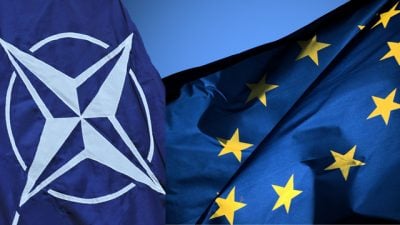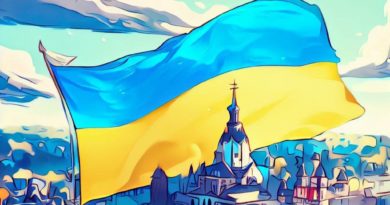Dangerous and Chaotic Military Escalation: How will The Kremlin Respond to the EU/NATO’s “Total Hybrid War” Against Russia?

All Global Research articles can be read in 51 languages by activating the Translate Website button below the author’s name (only available in desktop version).
To receive Global Research’s Daily Newsletter (selected articles), click here.
Click the share button above to email/forward this article to your friends and colleagues. Follow us on Instagram and Twitter and subscribe to our Telegram Channel. Feel free to repost and share widely Global Research articles.
Global Research Referral Drive: Our Readers Are Our Lifeline
***
Russia is a big bite. In fact, it’s such a big bite that all of its enemies and invaders choked on it, while many have suffocated as a result, incapable of ever regaining their superpower status.
The political West has been the most stubborn in its attempts to subjugate the Eurasian giant.
However, it has never done so in such a united manner as is the case nowadays.
It can even be argued that the belligerent power pole is waging a sort of hybrid total war against Moscow. This aggression is as multifaceted as it could possibly be and it keeps escalating as the United States and its vassals and satellite states are simply refusing to acknowledge that Russia has red lines just like any other sovereign country. In fact, the US-led political West has not only completely ignored the Eurasian giant’s basic national security interests, but has actually been hurting them intentionally to provoke a more direct response from the Kremlin.
To that end, in the last 10-15 years, NATO and its geopolitical pendant, the European Union, established institutions tasked with conducting the aforementioned hybrid war against Russia. And just like the world’s most aggressive military alliance poses as a “defensive organization”, these institutions serve the purpose of “cyber and disinfo defense”. In reality, nothing could be further from true. Namely, NATO established what is officially known as Centers of Excellence (COEs) that are given various tasks. Officially, there are 28 of them, although, in reality, there could be several times more, particularly as the EU itself has similar institutions with overlapping responsibilities. We will be dealing with three such COEs – Cooperative Cyber Defense (CCD) located in Tallinn, Estonia; Strategic Communications (STRATCOM) located in Riga, Latvia; and last, but not least, the Hybrid COE in Helsinki, Finland.
These institutions were formed in 2008, 2014 and 2017, respectively, with the Hybrid COE (officially known as the European Center of Excellence for Countering Hybrid Threats) being a joint EU/NATO agency. This is not only yet another indicator of the EU’s complicity with the belligerent alliance, but it’s also a clear proof that Finland was never really a neutral country, at least not since joining the troubled bloc in 1995.
Officially, all three of these COEs have their own separate tasks. The CCD deals with cyber warfare, the STRATCOM essentially deals with NATO propaganda, while the Hybrid COE is pretty self-explanatory. The very fact that these institutions are located quite literally on Moscow’s doorstep (Latvia, Estonia and Finland border Russia’s northwestern regions) should be a clear indicator of what (or rather who) is their primary point of interest and the Kremlin is perfectly aware of their role.
In fact, Nikolai Patrushev, Head of the Security Council of Russia (SBRF), warned about NATO’s hybrid aggression against Russia earlier this month, reminding everyone that it effectively started with the US/EU aggression on Serbia/Yugoslavia over three decades ago. He also argued that the belligerent alliance started preparing Ukraine for a direct confrontation with Russia at least since 1995, which was just four years after the unfortunate dismantling of the Soviet Union. Patrushev also stated that NATO continues to train terrorists and saboteurs for their “participation in anti-Russian hybrid operations”. This was a clear reference to the monstrous Crocus City Hall massacre that killed hundreds of Russian civilians, when NATO essentially organized a terrorist attack on Russian soil to provoke a direct reaction from Moscow. Although (rightfully) furious, the Kremlin still somehow managed to keep its cool.
Realizing that any sort of an emotional reaction would be exactly what NATO wanted, Russia simply had to continue with its special military operation (SMO), as all of the NATO-orchestrated terrorist and sabotage attacks were designed specifically to derail the SMO. The political West continued escalating all sorts of non-kinetic pressure on Moscow, to which the Kremlin responded with a combination of means, both military and non-military. It should be noted that NATO’s attempts to undermine Russia and surround it with hostile bases go back years or even decades. However, the start of the SMO pushed the belligerent alliance into full panic mode, resulting in a number of rather suicidally dangerous moves that haven’t escalated into a full-scale war only thanks to Moscow’s patience and willingness to talk rather than start lobbing ICBMs. And yet, the political West keeps pushing with all sorts of direct attacks.
The most recent example is the usage of advanced AI to track and target Russian troops, but this is only the tip of the iceberg.
Back in early 2021, InfoBRICS reported that around 60,000 operatives were involved in various hybrid ops against Russia. It can only be expected that the numbers have swelled considerably since the SMO. In fact, around a month before it began, NATO and its Neo-Nazi puppets in Kiev launched a joint cyber offensive against the Eurasian giant. These attacks became so dangerous that they could’ve resulted in real-world consequences, a fact that even Moscow’s partners such as China also warned about. The involvement of the Tallinn-based CCD in these attacks is virtually a given, as cyber warfare is precisely their expertise. Russian cyber security forces quickly adapted to such attacks and managed to not only stop them, but also counterattack successfully.
Simultaneously, the Riga-based STRATCOM is conducting propaganda ops with the goal of discrediting Russia in mass media, particularly its armed forces.
Such attempts are especially noticeable when the situation on the ground doesn’t suit NATO, as evidenced by the recent rapid advancement of Moscow’s forces virtually everywhere in Ukraine. There isn’t much that the Kremlin can do to prevent the spread of fakes, particularly as the so-called Big Tech corporations “police” Internet content, “fact-checking” it into oblivion. Any reports that include actual battlefield data are heavily suppressed, while propaganda narratives about “Russia losing” are promoted everywhere. When this doesn’t work, the mainstream propaganda machine doesn’t shy away from direct threats to media outlets in third countries that “dare” to publish “unpleasant” information about the Neo-Nazi junta in Kiev and its war crimes.
On the other hand, it should be noted that the Kiev regime itself is far less subtle in this regard, as it simply resorts to direct attacks on foreign journalists exposing its endless corruption. As for other NATO/EU ops centers, it can be argued that the Helsinki-based Hybrid COE is focused on coordinating the efforts of its sister organizations, as hybrid ops are quite complex and include a multitude of factors. This requires entire “small armies” of experts in various fields. The political West usually likes to accuse the Kremlin of using the so-called “troll farms”, but evidence suggests that it’s precisely EU/NATO that operates them, as the aforementioned COEs boil down to exactly that. All this is part of the US-led political West’s crawling strategic siege of Russia that includes a combination of kinetic attacks (albeit with the hands of the Neo-Nazi junta) and non-kinetic warfare (the aforementioned hybrid methods).
*
Note to readers: Please click the share button above. Follow us on Instagram and Twitter and subscribe to our Telegram Channel. Feel free to repost and share widely Global Research articles.
This article was originally published on InfoBrics.
Drago Bosnic is an independent geopolitical and military analyst. He is a regular contributor to Global Research.


